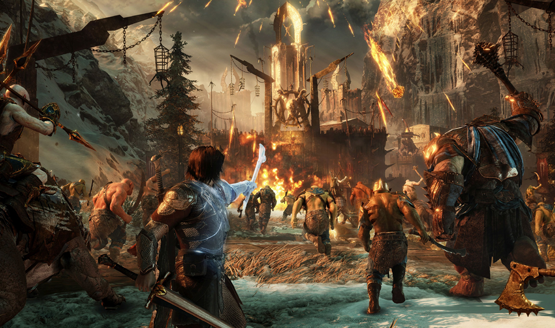As a long time Tolkien fan and gamer, I always get giddy when the two worlds collide, but it was always retellings of Tolkien’s stories. Few dared venture an original work set within the world, as the Middle-earth lore is precious to fans. In 2014, Monolith subverted expectations by releasing Middle-earth: Shadow of Mordor. Taking on neither the name of The Hobbit nor The Lord of the Rings, Monolith created an original story set within one of the holes–both temporally and geographically–in Tolkien’s lore. Monolith was free to create an adventure that we and many other critics gave high marks to. Three years later, Talion and Celebrimbor are back in Mordor as Middle-earth: Shadow of War further improves on the many unique points of the first.
Let’s talk lore. It’s an important point for Tolkien fans–perhaps the most important. Does Shadow of War step on the toes of known Tolkien lore presented in the likes of The Lord of the Rings, The Hobbit, and The Silmarillion? The answer to that is unequivocally yes, but then so do the six recent movies we’ve all come to love and enjoy. To be able to create a story that is rich enough for its own telling in-game–whether you’re a longtime Lord of the Rings fan or new to the world–is going to require concessions to be made. Some timelines may be off and characters are geographically located where they wouldn’t be according to Tolkien. You could get into a whole mess of words about how Monolith screwed up the canon in the first game (many people already did), but then, so to did the movies change some key elements from the original Tolkien works.
Any licensed property is going to demand a certain amount of creative freedom. It is up to the audience to suspend their disbelief and find enjoyment. Getting past Monolith crafting a puzzle piece that doesn’t quite fit within original Tolkien lore, the lore they have in-game is impressive and wide ranging. Everything has a story. Picking up Gondorian artifacts scattered around Mordor not only prompts voice overs about their history, but then sparks conversation between Talion and Celebrimbor about each one. Selecting a mission waypoint on the map sets the two talking. Retrieving Shelob’s memories unveils even more. The lore for Shadow of War is set upon the foundations of Tolkien’s writing and achieves a scope of its own, even if it does divert from the canonical path to some extent.
One Player to Rule Them All
Retrofitting Tolkien’s work allows Monolith to create some of the most interesting gameplay mechanics of any game to date. Shadow of War sits at a crossroads, having mobility like Assassin’s Creed, combat like Arkham City, and a wealth of abilities and loot like an RPG. While simply looking at gameplay makes it seem like an Assassin’s Creed game with a Lord of the Rings skin (the first game ran into the same early criticisms), it’s the ability to build out Talion as the character I wanted him to be that really sets this apart. More than two dozen skills can be unlocked, each with three sub-skills, of which only one can be selected at a time. It creates interesting moments in player choice, and rather than running forward into each combat encounter, I found myself fiddling with the skill tree to best handle each situation.
Similarly, killing orc captains and other tasks in the game will grant loot, some with special abilities. Is it worth it to drop my attack power with my sword in order to generate a life-steal effect on critical hits? This cloak may have higher stealth, but it doesn’t do increased damage from poison attacks. Each piece of gear not only has effects on Talion, but also changes how he looks, so I got a clear visual representation of the advancements and changes I was making to my character. Player freedom extends into the options menu, which has a number of toggles for various aspects of the HUD.
Depth of character build wouldn’t be so unique except for the Nemesis System. There’s a hierarchy of orcs–captains, warchiefs, and overlords. Talion eventually gets the ability to sway orcs to his cause, allowing me to infiltrate their ranks and get orcs to fight my battles for me. A series of weaknesses and strengths made each orc different from the next. Encountering them in the world unexpectedly meant I had to be on my toes and adjust tactics to defeat them. While the first game trotted out something special that has yet to be replicated, Shadow of War continues to make it more interesting.
In addition to the ecosystem, traits, and conflicts of the orcs being much deeper than the first, there are now fortress assaults that mimic the scale of massive Lord of the Rings battles like Helm’s Deep or the siege at Minas Tirith. I can equip orc captains with different armies that offer different benefits to take on the varied defenses that each stronghold has, then I jump in and join the fray myself to capture and set my own overlord to rule it. The Nemesis System is a game of tactics throughout, and managing the loyalty of a full orc army is not as easy as it may seem. Moreso than the main campaign, this interaction with the orcs–ambush, support, betrayal, and war–is what will create the fascinating player stories for Shadow of War.
An Unexpected Journey
Ûkbûk the Avenger had dogged me all throughout Núrn. He’d show up unexpectedly while I was mid-battle. He learned and adapted to my tactics of vaulting while fighting him. He was immune to arrow shots. He would flee before I could kill him, or put me in such a dire place where I would need to flee myself. He even killed me once, growing in power. I quickly learned to recognize Ûkbûk’s sneering profile, and just as quickly learned to hate it. Finally, I caught up to him. He was broken, able to be be dominated. Instead of killing him, I swayed him to my side. My greatest foe would be my strongest ally.
I set him against other captains in the area and then I made an assault on the fortress. Of course I wasn’t going into this massive battle without my most powerful weapon, so Ûkbûk was at my side along with a couple of other captains I had convinced to fight for me, outfitted with a contingent of Caragor riding warriors. Together we stormed the stronghold, tearing down walls and laying waste to the opposing orcs. None could stand against us–or so I thought. At some point during the assault, Ûkbûk was killed, and I wasn’t there to revive him. I smiled slightly. The bastard had served his purpose. Things moved on.
Once more, I was wrong. A short time later, a familiar face assaulted me mid-battle. Ûkbûk, now with an ax wedged into his skull, had returned from the grave to get revenge on me for abandoning him in the midst of the assault. Now leveled up, I was able to more easily take on this death-defying orc captain, and instead of recruiting him into my army again (I couldn’t forgive this betrayal), I ended his life for the second time. Then it happened again. He popped up while I was in a heated fight and continued to taunt me, with voice lines that indicated he was aware I was frustrated at his betrayal and re-emergence. And I ended him again, cleaved in half at the waist this time, so hopefully Ûkbûk’s axe-bearing face doesn’t return.
It’s a story that played out over hours of game time, weaving itself with other interactions. Failure to help one of the captains out on a raid may result in their betrayal of me. Assisting another might strengthen their resolve in my army. As orcs die, new ones come in with new traits to adapt to. My Nemesis is even shown on the pause screen, so their veneer gets me riled up each time I want to check my gear or change skills. The system lends itself to repeated playtime, a distraction that legitimately feels like a natural part of the world order in Mordor. After all, it’s hard to continue to get story quests done when I’m haunted by the cloven face of Ûkbûk.
In For a Penny
Never once during my time with Shadow of War did I feel that loot boxes, microtransactions, or additional purchases were pushed on me. In fact, the ability to buy currency for loot boxes is buried underneath two menus, and the game never specifically directed me to them. It’s even so light of a touch that earning loot boxes in-game is barely communicated, and I had four of them to open by the time I started deeply exploring the menus. While it may appear to be out of place when thought of in context of Shadow of Mordor, the loot boxes and randomized items make a kind of sense for the more RPG and tactical board game side of things in Shadow of War. This game is about building an army, not just in the confines of the orcs you can see for each region, but also in preparing defenses for your strongholds and having bodyguards.
The ability to purchase these loot boxes may be controversial, but the system never felt balanced in a way that encouraged me to. I always had a good supply of gear otherwise. With so much else resonating player freedom in Shadow of War, it makes sense that players willing to spend money are free to do so in order to save some time that would otherwise be spent grinding out the same rewards. I personally felt like earning an orc or piece of gear in battle was much more rewarding than paying for the same content, but I also can’t call the microtransactions in Shadow of War a negative that in any way impacted the experience that I had.
I did run into some minor performance issues, most often when using photo mode laden with heavy effects processing, but the game runs very smoothly otherwise. There are a couple of problems that have nagged games with this type of movement, like getting stuck briefly on objects or jumping to the wrong ledge, but often that was due to my own rushing and haphazardly approaching obstacles instead of being direct about where I wanted to go. There will be a day one patch to address a number of rare issues that can crop up, and our testing was done with the latest patch installed.
An expanded Nemesis System creates fascinatingly interesting player stories, and the amount of freedom afforded to the player is staggering for a game of this scope. Microtransactions never get in the way of the game itself, so any objection to them is based purely on personal principles. Lore purists may find fault with Middle-earth: Shadow of War, but those willing to suspend their disbelief and enjoy the game Monolith built around Tolkien’s world will find the best Lord of the Rings game to date. With the immortal words of Samwise Gamgee at my lips, I smile and walk into Mordor, returning to the Gondorian boots of the Gravewalker: “Well, I’m back.”
Middle-earth: Shadow of War review code provided by publisher. Version 1.03 reviewed on a standard PS4. For more information on review scores, please read our Review Policy.
-
Nemesis System creates interesting and unique player stories
-
Extensive lore scattered across the game
-
Player freedom in building out your character
-
Deep and tactical gameplay within the orc ecosystem
-
Microtransactions are not intrusive at all
-
Minor slowdown while using photo mode
-
Microtransactions will inevitably turn some players away









